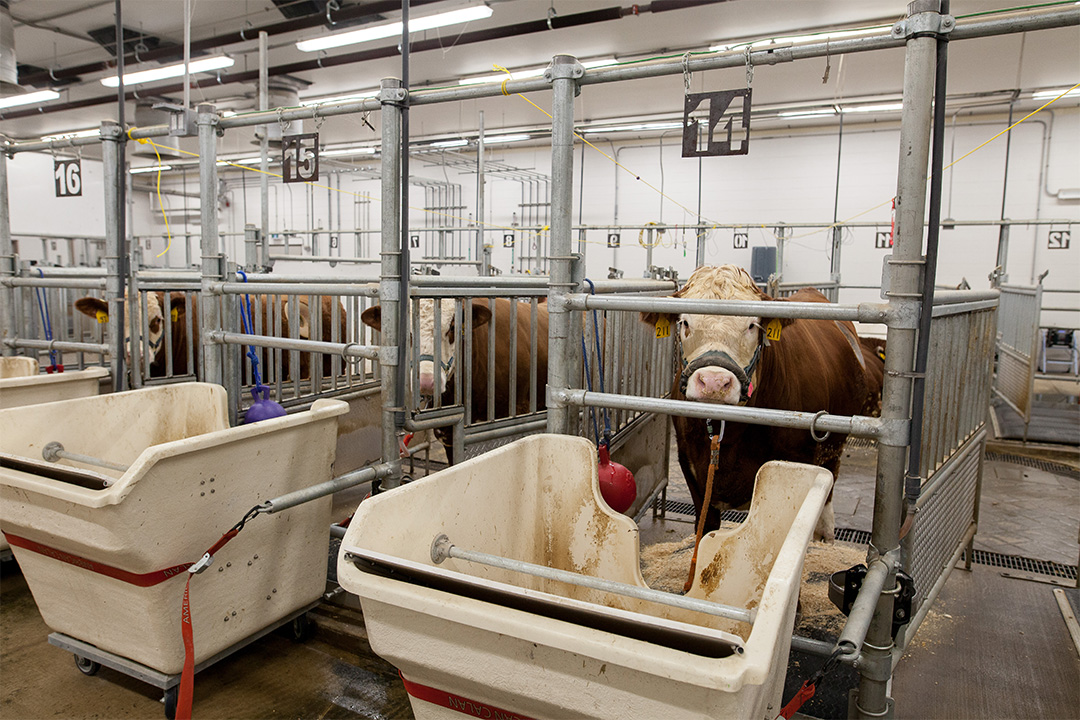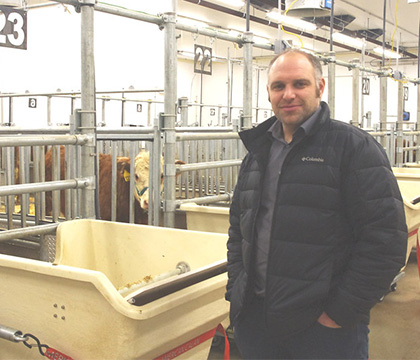
Drinking water study shows beef cattle can tolerate high levels of sulphates
Scientists at the University of Saskatchewan are surprised that research they published today shows beef cattle can tolerate higher concentrations of sulphates in drinking water than previously believed.
By Lana HaightSaskatchewan has the benefit of having ample water available for cattle to drink, but much of that water has high concentrations of minerals.
“Based on existing recommendations for water sulphate concentrations, one of those minerals in water, I thought we would see a reduction in water intake, which would lead to a reduction in feed intake, and if both of those happened, then growth would decrease,” said Dr. Greg Penner (PhD), associate professor in the Department of Animal and Poultry Science and the USask Centennial Enhancement Chair in Ruminant Nutritional Physiology.
The Effect of Water Sulfate Concentration on Feed and Water Intake, Growth, and Serum Mineral Concentrations in Growing Beef Heifers, published today in Applied Animal Science, shows that wasn’t the case.<hyperlink to the page> This research was the first to be conducted in the highly specialized metabolism barn at the university’s Livestock and Forage Centre of Excellence, located south of Clavet.

While Penner led the study, he worked closely with his collaborators from the Ministry of Agriculture: Leah Clark, the province’s livestock specialist, and Colby Elford, a livestock and feed extension specialist. They were assisted by university student researchers Jordan Johnson and Brittney Sutherland.
In December 2018, 16 heifers were housed in individual stalls with separate water bowls allowing the delivery of water differing in quality while simultaneously measuring water intake. One group of four was a control group, receiving water with no sulphates added. The other groups of four each received water with 1,000, 2,000 and 3,000 mg of added sulphates per liter of water to mimic real levels experienced by some Saskatchewan cattle producers. The study was repeated in March 2019 with another 16 heifers. When sulphates in drinking water are too high, they bind with trace minerals in the rumen, making those minerals unavailable for the animal’s body to absorb.
Penner acknowledges that because the heifers were housed in the climate-controlled metabolism barn, they weren’t exposed to extreme heat and UV rays. They also had unlimited and easy access to water at all times, which may have allowed them to tolerate the higher concentrations. Exposure to heat and UV rays may increase water intake which then may increase the impact of water with high sulphate concentrations.
At first glance, today’s research results seem to be good news for Saskatchewan and for cattle producers who have water sources containing high levels of sulphates in wells and dugouts, but Penner is cautious.
“We did see reductions in serum copper, one of the most affected trace minerals by sulphate. There could be longer term affects in terms of reproductive efficiency. A producer might not see anything in terms of growth rate, feed intake and water intake, but those negative impacts may be hiding deeper and may be affecting trace mineral status, which could affect fertility.”
Penner says he understands that producers might want definitive answers faster than the research allows. So, what is his recommendation when the current guidelines vary by provinces and the federal government and are well below the 3,000 mg/L?
“It’s not clear-cut negative or positive, but I think there are clear implications from the research,” he said, adding that throughout the summer, producers need to be considering water quality and water access for their animals to ensure the water is safe. This involves regular testing to monitor dissolved mineral concentrations to ensure current guidelines are followed.
Funding for the published study was provided by the Saskatchewan Ministry of Agriculture and the Canadian Agriculture Partnership through the Strategic Field Program. The Roy Romanow Provincial Laboratory provided water quality analysis as an in-kind contribution.
This is the first of a series of water quality studies that Penner will conduct.
His next project is a three-year study in collaboration with researchers at Texas Tech University, within the Department of Animal and Poultry Science, Large Animal Clincial Sciences at the Western College of Veterinary Medicine, and the Saskatchewan Ministry of Agriculture that was set to start in April. Cattle will receive water with sulphate concentrations as high as 4,500 mg/L to determine the level at which cattle are negatively affected by the sulphates.
Another component of this study is testing various ways to interfere with the sulphates’ binding of trace minerals in the rumen.
Bismuth subsalicylate, a commonly found antacid, is known to bind with sulfides. That in turn could diminish the effect of sulphates in water that is consumed by cattle, reducing the problem before it starts.
Funding for this project was announced at the end of January.
And looking down the road, Penner hopes to move the research from the barn to the field, where animals would be housed in outdoor pens and provided with water that is naturally high in sulphates. The goal is to clearly understand appropriate water quality standards to help producers to continue to raise healthy and productive beef cattle.
Article re-posted on .
View original article.

